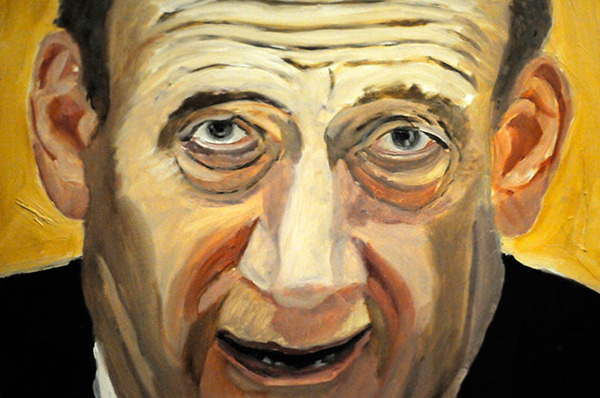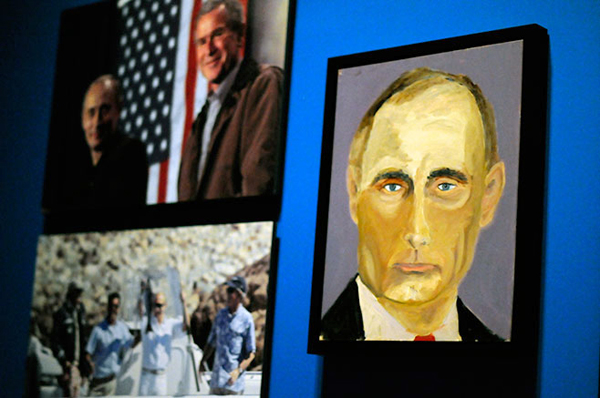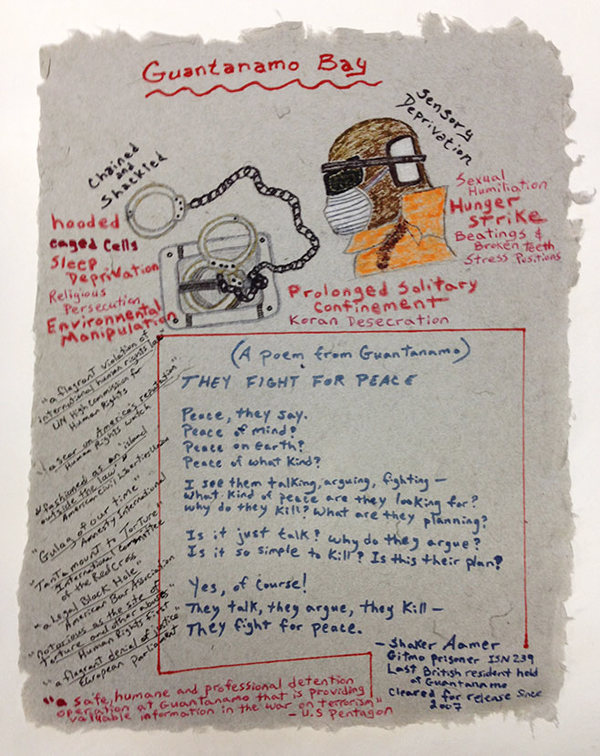But they are fascinating.
The greatest work of art George W. Bush ever took part in was in 2008, when an Iraqi journalist threw two shoes at his head. “This is a farewell kiss from the Iraqi people, you dog,” screamed the journalist, Muntadhar al-Zaidi, who had been arrested twice by U.S. forces during the occupation.
Bush dodged the shoes with the same ease with which he’d had dodged consequences all his life; those for drunk driving, for ruined companies, stolen elections, war crimes, the destruction of Zaidi’s country.
After he dodged the shoes, Bush joked about free countries. Meanwhile, guards beat Zaidi bloody. Police tortured him during the nine months he served in jail.
Bush’s first art exhibition, “The Art of Leadership: A President’s Personal Diplomacy,” lacks the apt metaphor of Zaidi’s shoe throw. Bush’s 30 oil-on-board portraits of world leaders will hang at the George W. Bush Presidential Center in Dallas through June 3. As artifact, they’re fascinating, even if as art they’re not.
We first got a glimpse at Bush’s paintings in 2013, when a hacker leaked an early batch online. Two nudes went viral—Bush’s feet in the bath and Bush’s back in the shower. What was up with all that bathing imagery? Was he trying to wash out that damn spot? Presidential flesh is still a rarity, even though Bush was renowned for giving unwanted massages, choking on pretzels and wiping his sweaty hands on Bill Clinton’s shirt. But those nudes, unlike the latest paintings of world leaders, were not meant for public consumption. Bush’s exhibition is for posterity. A gift from him to us.
Bush paints like a freshman art student attempting alla prima, which means doing a whole painting in one sitting. It looks easy but often comes off terribly when done by newbies. As you apply fresh paint strokes, the ones you just did smear hopelessly. All your colors mash to mud. I don’t say this to criticize Bush. I still can’t paint in oils. Waiting for each layer to dry before you do the next is torture—though not the kind Bush is familiar with.
Oil paint is the least transparent and most frustrating of mediums. Staring at a finished painting from the outside, it is almost impossible to figure out the infinite manipulations that went into its creation. A Velazquez is as hard to decipher as a covert government agency.
Bush’s portraits of world leaders are copied from Google Image Search. Since the birth of photography, most artists have used photo reference, but I’m a bit disappointed that he didn’t take advantage of his unique access to his models. After all, Bush wouldn’t want to pull a Shepard Fairey and have some disgruntled photographer come after him for copyright infringement. It’s embarrassing enough that bands are suing because their music was played to torture prisoners at Guantánamo.
Photo reference, overused, lends itself to a stiffness. Accidents of lighting and position get overemphasized if you don’t take them into account. Was Bush really apt enough to deliberately paint Ehud Olmert’s mouth open in a sneer of horror? Or did he just choose a photo that caught the Israeli prime minister mid-speech? I would compliment Bush on nailing Vladimir Putin’s blank sociopathy. He did say, looking into the Russian leader’s eyes, that he “was able to get a sense of his soul.” But knowing Bush, I have to credit the photo. Putin always looks like that.
Art is supposed to show sophistication, introspection. Unlike our current president, Bush never seems to be a sophisticated or introspective man. But as someone who sometimes paints for 14 hours a day, I think the ethical power of creativity is overrated. Art, books, music—these are joys and addictions, but they no more make you moral than playing checkers does. If they did, Obama, a man steeped in great literature, wouldn’t incinerate kids with drones.
Writer Teju Cole twittered that if paintings of war are hot, those of the War on Terror are cold. Bush’s palate is as icy as Lucian Freud’s. Inside the cellblocks at Gitmo, where men have languished for more than a decade, not charged with any crime, the palette is cold too—fluorescent bulbs on concrete. I wonder if Bush ever sketched there. Abu Zubaydah did. He was rendered by the CIA, tortured and locked forever in the secretive Camp Seven. Documents obtained through recent Freedom of Information Act requests reveal that Zubaydah drew the torture inflicted on him. The drawings, however, are classified.
I recently gave a lecture on Guantánamo at Rutgers University. I shared the podium with James Yee, Muslim chaplain to detainees at the prison from 2002 to 2003. After objecting to torture, Yee was held in solitary confinement on a naval brig for 76 days, subjected to the same shackles and sensory deprivation he’d seen used on detainees. The government told the media he was a spy for al Qaeda. He was later released without charge.
Since last November, Yee has been drawing. He works as an outreach coordinator for Combat Paper, a series of workshops by and for veterans, who pulp their old uniforms into paper. On this paper, they grapple with their military experiences. Eighty percent of them served in Bush’s wars in Afghanistan and Iraq.
Carefully, Yee showed me the paper. It’s rough, heavy, colored like grass and sand. “This was a battle dress uniform,” he said. “This was a dress shirt.” “This was desert camouflage from Operation Iraqi Freedom.” He wants to make paper out of an orange jumpsuit from Guantánamo.
Then, Yee took out his own work.
In clear lines reminiscent of Marcel Dzama, Yee drew his imprisonment. He drew the shackles that chained him, the industrial earphones that kept him from hearing, the hood, the blackout goggles and the surgical mask over his mouth. Next to the art, Yee wrote lists of tortures done at Guantánamo: “beatings, broken teeth, prolonged solitary confinement, religious persecution.” He filled the page with a poem from British detainee Shaker Aamer. Yee told me that pictures reveal something that words cannot express.
He had never heard of Bush’s art.
Yee must be the last person who can say this, because the media loves Bush’s paintings. They’re ideal clickbait-kitsch from a boy who would grow into an adorable grandpa, without ever becoming an adult. Bush grins in his painting smock and we laugh. An art exhibit is the benign cherry on his lifetime sundae of fail. Some in the media even wonder if art is therapy for him. Is Bush haunted by what he has done?
I believe Bush paints because Bush can do anything. Every American dream, Bush got—an Ivy League education, running his own sports team, even the presidency. When each dream ended in failure, he grinned and moved on. Bush’s paintings are one more way of turning away from the past, just as he ignored the trail of blood Zaidi left as guards dragged him from the room.
Unlike Bush, Yee does not have the privilege of forgetting.
The two men, perpetrator and victim of the War on Terror, make their pictures. At his multimillion-dollar ranch, Bush playacts the dream of being an artist.
Meanwhile, Yee, Zaidi and all the rest of us live in the real world—the world that Bush and his friends built.
Molly Crabapple is an artist and writer. She is working on a memoir, Drawing Blood, for Harper Collins.









